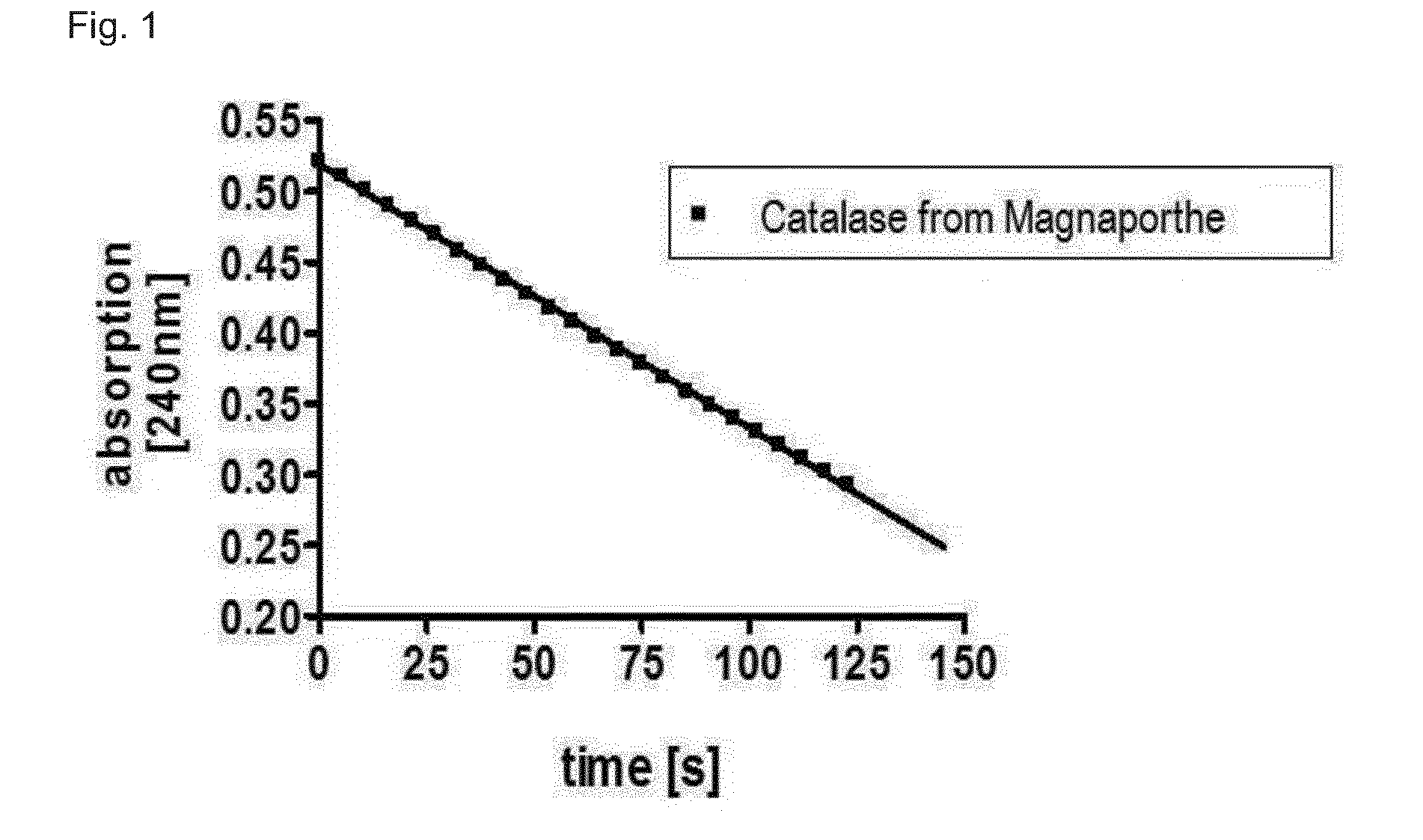Catalase in growth media
- Summary
- Abstract
- Description
- Claims
- Application Information
AI Technical Summary
Benefits of technology
Problems solved by technology
Method used
Image
Examples
example 1
Preparation of Agar Plates
[0053]
TABLE 1Components of TSA-LT agar growth mediumIngredientg / lCasein peptone15.0Soy peptone 5.0Sodium chloride 5.0Agar15.0Lecithin 0.7Tween80 5.0
TSA-LT Stands for Tryptic Soy Agar with Lecithin and Tween.
[0054]TSA-LT agar growth medium was prepared by adding into each half-liter screw-cap bottle 16 g CASO agar powder, which contains the first four components of Table 1 premixed, 0.28 g lecithin, 2 g Tween80 and 400 ml pure water. After autoclaving at 121° C. for 20 minutes, the medium was cooled down to 50° C. in a water bath. Catalase solutions, or other solutions with additives, were added with sterile filtration. After mixing, 30 ml growth medium were poured into each petri dish with a diameter of 90 millimeter. The next day the agar plates were packed in plastic foil and some plates were gamma-irradiated with 20.5 kGy.
[0055]Catalase solutions were prepared as described below, sterile filtered, stored at 4° C. and their concentration measured as descr...
example 2
Agar Diffusion Test
[0059]
TABLE 2Components of LB-T growth mediumIngredientg / lTryptone10.0Yeast extract 5.0Sodium chloride 5.0Tween20 5.0
[0060]Bacillus subtilis ATCC 6633 was grown in LB-T growth medium (see Table 2) overnight at 37° C. The Bacillus suspension was diluted with LB-T growth medium to an OD600 (optical density at 600 nm) of approximately 0.1. This diluted Bacillus suspension (200 μl / plate) was spread onto dry TSA-LT agar plates from Example 1. Four paper discs were put onto each agar plate. The paper discs had a diameter of 6 mm and were prepared from gel blot paper GB003 from Whatman with a hole punch. 10 μl of an aqueous solution that contained hydrogen peroxide at a concentration of 2%, 5%, 8% and 10%, respectively, were pipetted onto the four paper discs on each agar plate. Afterwards the plates were incubated overnight at 37° C. The diameter of the inhibition zone was measured and the diameter of the paper disc subtracted and the result divided by two. Thus a repor...
example 3
Growth Promotion Test
[0062]Bacillus subtilis ATCC 6633 was grown in LB-T growth medium (see Table 2) overnight at 37° C. The Bacillus suspension was put on ice and diluted to an OD600 of approximately 0.1 with a PBS solution that has a pH of 7.4 and contains 8 g / l sodium chloride, 0.2 g / l potassium chloride, 0.2 g / l potassium dihydrogen phosphate and 0.918 g / l disodium hydrogen phosphate. This diluted Bacillus suspension was further diluted 10,000 times with the PBS solution and kept on ice. Meanwhile, 300 μl 1% hydrogen peroxide solution was spread onto a dry plate, which contains 30 ml TSA-LT agar growth medium (see Example 1). Thus a concentration in the growth medium of 100 ppm (parts per million) hydrogen peroxide was applied. The plate was dried for 20 minutes at room temperature (20-25° C.). Then 200 μl 10,000 times diluted Bacillus suspension was spread onto the agar plate. Afterwards the plates were incubated overnight at 37° C.
TABLE 5Colonies on agar platesAdditivesConcent...
PUM
| Property | Measurement | Unit |
|---|---|---|
| Temperature | aaaaa | aaaaa |
| Fraction | aaaaa | aaaaa |
| Time | aaaaa | aaaaa |
Abstract
Description
Claims
Application Information
 Login to View More
Login to View More - R&D
- Intellectual Property
- Life Sciences
- Materials
- Tech Scout
- Unparalleled Data Quality
- Higher Quality Content
- 60% Fewer Hallucinations
Browse by: Latest US Patents, China's latest patents, Technical Efficacy Thesaurus, Application Domain, Technology Topic, Popular Technical Reports.
© 2025 PatSnap. All rights reserved.Legal|Privacy policy|Modern Slavery Act Transparency Statement|Sitemap|About US| Contact US: help@patsnap.com

